Source, by: Flags of the World




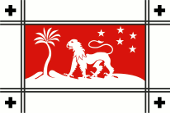
1885–1895,
Flag of the German East African Company (DOAG),
ratio = 2:3(?),
Source, by: Flags of the World



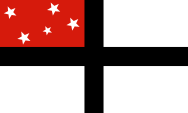
1895–1920,
Flag of the German East African Company (DOAG),
ratio = 3:5,
Source, by: Flags of the World



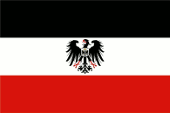
1898–1919,
Flag of the Governor of German East Africa,
ratio = 2:3,
Source, by: Flags of the World



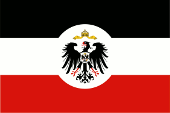
1892–1919,
German Empire,
Official flag colonial office / foreign office,
ratio = 2:3,
Source, by: Flags of the World



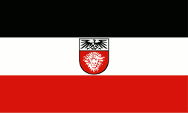
1914,
planned flag for German East Africa,
ratio = 3:5,
Source, by: Flags of the World, Flag Reconstruction
following Mark Sensen (Feb 98)
based on traditional interpretation from Afrika-Nachrichten article 1933



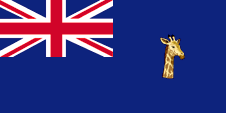
1919–1961,
Flag of the government (state flag),
ratio = 1:2,
Source, by: Flags of the World



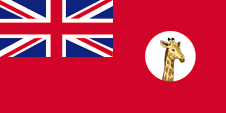
1919–1961,
Merchant flag,
ratio = 1:2,
Source, by: Flags of the World



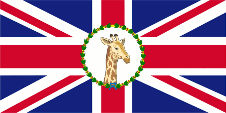
1919–1961,
Flag of the Governor,
ratio = 1:2,
Source, by: Flags of the World



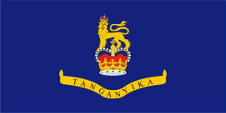
1961–1962,
Flag of the Governor General,
ratio = 1:2,
Source, by: Flags of the World




The flag of Tanganyika was based on the flag of the TANU party. It was created on the occasion of independence in 1961 by adding narrow yellow dividing stripes between black and green on the TANU flag. When Zanzibar merged with Tanganyika to form Tanzania, the flags of both countries were merged to form the current national flag of Tanzania.
Under the administration of the German East Africa Company (1885–1890), this organization's flag was used. The flag, created in 1885, was white with a red center field separated from the white edge by black double lines that extended to the edge of the flag. In the red center field, a stylized landscape appeared in white with a lion, a palm tree and the five stars of the Southern Cross. The corners of the flag showed four black Greek crosses with bars of equal length. In 1895 a new flag was adopted for the company. It is called the Carl Peters flag or Peter's flag, after Carl Peters, the founder of German East Africa. This flag was plain white with a continuous black bar cross and a red upper corner, which displayed the constellation of the "Southern Cross" using five white stars. As a German colony, the country did not use a special national flag from 1890 onwards. The colors of the German Empire were used: black, white and red. Authorities used the flag of the Colonial Office as well as variations of it. It was horizontally striped in black, white and red and showed a white disc with the imperial eagle in the middle. From 1913 onwards, consideration was given to creating their own national emblems for the colonies. The first drafts were available in 1914, but the project was no longer implemented due to the outbreak of the First World War and the loss of the colonies.
After Tanganyika was placed under British administration as a mandated territory of the League of Nations after the end of the First World War and as a result of the Versailles Dictate, the British flag system was introduced with a "Blue Ensign" and a "Red Ensign", a red and a dark blue flag bunting with a Flag depiction – the British Union Jack – in the upper corner. The Union Jack indicated the connections to United Kingdom.
United Kingdom introduced a flag system in 1864 in which:
• war ships fly the "White Ensign" (naval flag), a white flag often with an uninterrupted red St. George's-Cross and with the Union Jack in the upper staff quadrant of the flag,
• merchant ships fly a "Red Ensign" (also named "Civil Ensign" → civil flag, the real merchant flag), a red flag with the Union Jack in the upper staff quadrant of the flag, and
• governmental ships fly the "Blue Ensign" (flag for the use by the gouvernment → the actual state flag), a blue flag with the Union Jack in the upper staff quadrant of the flag.
Since 1865 ships of colonial governments were permitted to fly the Blue Ensign with a badge in the flying end of the flag. The respective governments were asked to design appropriate badges. Merchant ships and seafaring persons from colonies were only permitted to use the Red Ensign with a badge, then also named Civil Ensign, if permission has been given to the respective colony by the British admiralty. This permission had been granted to Tanganyika so that a "Red Ensign", a red flag bunting with the British Union Jack in the upper corner and the badge of the mandate administration, could be used as merchant flag. The badge was a giraffe head, which was only depicted on the Red Ensign on a white disc.
Such a badge was often a regional landscape representation placed on a disk, often showing ships, historical events or even a kind of a logo. Very often, a badge also showed the name of the country or a motto. Some British possessions, however, already had a coat of arms from the beginning, or their badge was replaced by a coat of arms over the years. To ensure a uniform appearance in the flying end of the flags, coats of arms and other symbols were displayed on a white disk in the size of the earlier badges. There were also exceptions, because some colonies did not use the white disk and placed their escutcheon or even coat of arms directly on the bunting, sometimes enlarged. Already in the '40s they started to remove the white disk and placed the coat of arms directly or enlarged. This conversion process was done gradually, nowhere at the same time and completely. In some British possessions, flags with the white disc are still in use, in others no more and in some areas are both variants in use, next to each other.
Source:
1.) Flags of the World,
2.) Flags of the World,
Wikipedia (D),
Die Welt der Flaggen,
Volker Preuß


1914,
planned coat of arms of German East Africa,
Source, by: Flags of the World, Flag Reconstruction
following Mark Sensen (Feb 98)
based on traditional interpretation from Afrika-Nachrichten article 1933

1919–1961,
Badge of Tanganyika,
Source, by: Flags of the World
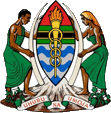
1961–1964,
Coat of arms of Tanganyika,
Source, by: Poohgun - junmon
[Public domain], via Wikimedia Commons

The coat of arms of the Republic of Tanganyika showed between 1961 and 1964 a Maasai shield with three fields arranged one below the other, including the national flag of Tanganyika, and blue wavy lines (sea) and above all a torch (freedom torch). Shield holders (supporters) are a Bantu man and a Bantu woman, both holding an elephant tusk. The shield rests on Mount Kilimanjaro, with coffee plants on the left and cotton plants on the right. The state motto is written in red letters on a white banner. It is in Swahili and reads: "Uhuru na Umoja" → "Freedom and Unity". The country was once a German colony. The German colonies – with the exception of Kiautschou (Kiaochow) – were subordinated to the Colonial Office of the German Empire. Accordingly, authorities used its seals, flags and the imperial coat of arms. From 1913 onwards, consideration was given to creating their own national emblems for the colonies. The first drafts were available in 1914, but the project was no longer implemented due to the outbreak of the First World War and the loss of the colonies. The intended appearance of the coats of arms and flags could only be reconstructed using fragments in the 1920s and 1930s. Most of the reconstructions refer to an article in the newspaper "Afrika-Nachrichten" from 1933 and the resulting reconstructions by the Dutch vexillologist Mark Sensen from February 1998, which are also included on these pages. The coats of arms of the colonies should bear the imperial crown above the escutcheon, but not on the flags, if one follows Mark Sensen's reconstruction. These heraldic shields always had the same structure: a horizontally divided shield, the head of which showed the imperial eagle on white with the breastplate of the House of Hohenzollern. The main part is a stylized representation of plants, animals or landscapes that were colored differently depending on the country. The planned coat of arms of German East Africa showed a white lion's head on a red background. During its time as a British mandate, the country had its own emblem, a so-called badge, the insignia of the mandate administration. The badge was a giraffe head, which was only depicted on the Red Ensign on a white disc.
Source:
Wikipedia (D),
Wikipedia (EN),
Volker Preuß

Area: 363.948 square miles
Inhabitants: ca. 9.000.000 (1961), thereof 95% Bantu Tribes, 2% Massai
Density of Population: 25 inh./sq.mi. (1961)
Capital: Dar es Salaam (Daressalam), ca 100.00 inh. (1961)
Languages: Swahili, English, Bantu languages
Currency: East African Shilling (Sh) = 100 Cents
Time Zone: GMT + 3 h
Source:
Wikipedia (EN)

Antiquity · settlement area of the Bantu tribes
10th century · invasion of the Islam along the coast
975 · foundation of Kilwa as Arabian trading base
1499 · Vasco da Gama sails along the coast on his way to India
1505 · conquest of Kilwa by the Portugese, appropriation of the whole eastern coast of Africa
1698–1730 · the coast of Tanganyika comes to Oman
1856 · death of the Sultan of Oman, in result of British pressure division of the country (division of the dynasty in two lines) in the Sultanate of Oman and the Sultanate of Zanzibar, the coast of Tanganyika comes to Zanzibar
17th of February 1885 · Carl Peters acquires places in the innards of the land in the name of the German East African Company (DOAG) from the Sultan of Zanzibar
27th of May 1885 · establishment of the protectorate of German East Africa including German Witu (situated in the today’s Kenya)
28th of April 1888 · the DOAG leases the coast of the mainland from the Sultan of Zanzibar
1st of July 1890 · Heligoland-Sansibar Treaty, the German Empire renounces its protectorate over Zanzibar, in countermove acquisition of the island of Heligoland from United Kingdom and the ceding of German Witu to United Kingdom
20th of November 1890 · the administration of the protectorate of German East Africa becomes taken away from the DOAG after riotings and agitations, formation of the colony of German East Africa
1896/1890 · frontier treaties with United Kingdom and Portugal
1914–1918 · First World War (1916 · British, Indian, South African, Belgian and Portuguese troops conquer German East Africa, resistance of the German protection troops until the 14th of November in 1918)
1918 · Portugese troops occupy the Ruvuma Triangle
1919 · Ruanda and Urundi come under Belgian control
1920 · the Ruvuma Triangle becomes ceded to Portugal (to Portugese East Africa [Moçambique])
20th of July 1922 · German East Africa becomes a British mandate of the League of Nations with the name Tanganyikas
11th of December 1946 · Tanganyika becomes a trust territory of the UNO
1954 · foundation of the TANU party (Tanganyika African National Union), it claims the independence of the country
1st of May 1961 · United Kingdom grants self-administration
9th of December 1961 · United Kingdom grants independence in the framework of the Commonwealth of Nations
9th of June 1962 · formation of the "Republic of Tanganyika"
27th of April 1964 · the People’s Republic of Zanzibar unites with the Republic of Tanganyika to the "United Republic of Tanganyika and Zanzibar"
29th of October 1964 · rename in "United Republic of Tanzania"
1965 · establishment of a single-party-system (TANU in Tanganyika, ASP in Zanzibar)
1977 · TANU and ASP unite to the CCM unity party
1978 · war with Uganda
1992 · end of the single-party-system
2000 · growing of the Tanganyika national movement
Source:
Atlas zur Geschichte,
Wikipedia (D),
Discovery '97,
Volker Preuß

The name "Tanganyika" means "Land of the many tribes". From there has the Tanganyika Lake its name too. In the times as German colony was used the name Deutsch-Ostafrika (German East Africa). After German East Africa was haded over to United Kingdom as a mandate of the League of Nations, the name could not be changed into British East Africa because already the today’s Kenya used that name. They remembered the old name "Tanganyika".
Source:
Handbuch der geographischen Namen,
Volker Preuß


![]()

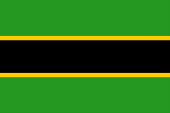












![]()
